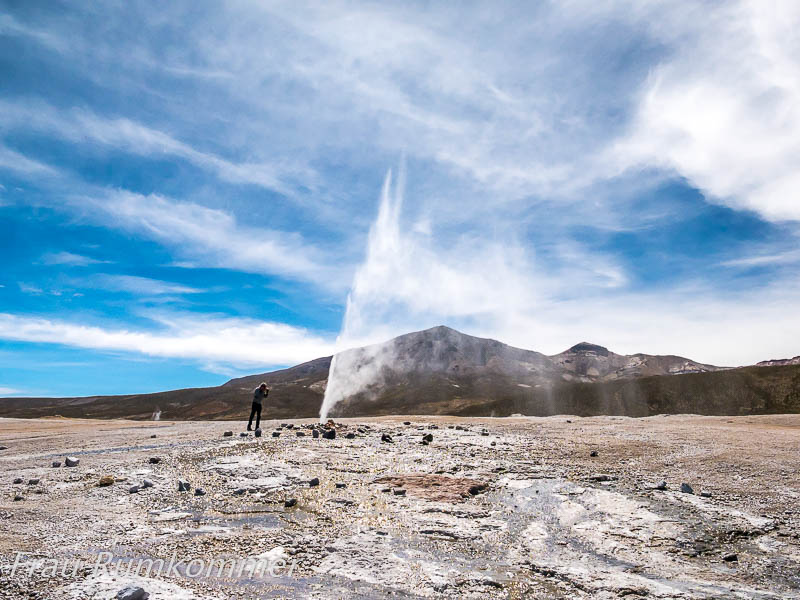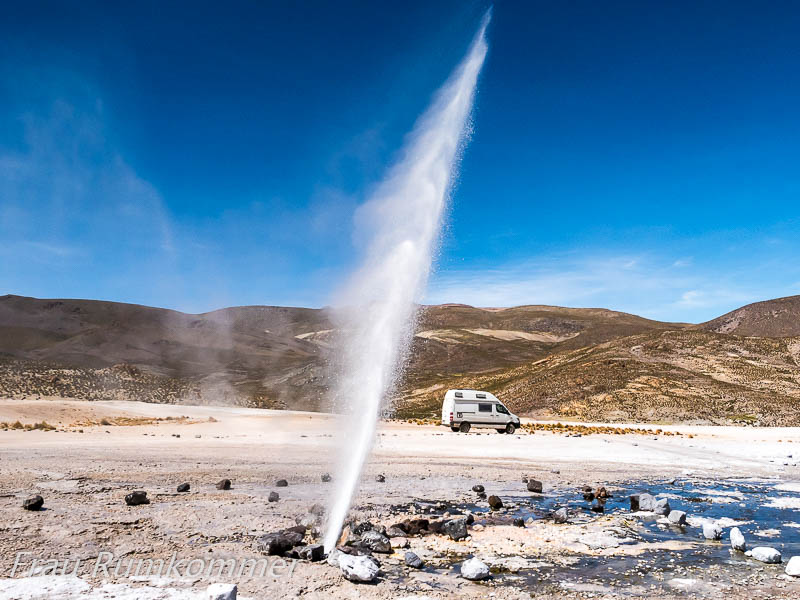
Ziemlich abgelegen und auf 4.300 m Höhe liegt die kleine Siedlung Puchuldiza. Seine Geysire sind unser Ziel. Chile liegt auf dem Pazifischen Feuerring. Erdbeben sind an der Tagesordnung, auch Vulkanausbrüche kommen vor. Die Anden sind ein relativ junges Gebirge, das noch nicht zur Ruhe gekommen ist. So gibt es auch Geothermalgebiete. Laut unserem Reiseführer gehören diese Geysire zu den schönsten in Nordchile.
Auf einer weiten Fläche machen wir mindestens drei Geysire aus. Dazwischen sind diverse sprudelnd kochende und spritzende Wasserlöcher sowie einige Fumarolen. Außerdem sind im Boden viele aktuell inaktive Öffnungen und Löcher. Neben dem aktiven Areal verläuft ein von der Geothermie gestaltetes Flusstal, in dem das Wasser aus den ganzen heißen Quellen pittoresk abfließt.
In dieser Höhe, in der jeder Schritt anstrengend ist, könnten wir diesen riesigen Park mit geothermischer Aktivität gar nicht hinreichend zu Fuß erkunden. Aber es gibt Fahrspuren, sodass wir mit dem Womo von einem Geysir zum nächsten fahren können. Zu unserer Überraschung und Freude sind wir ganz allein in dem Gebiet unterwegs.
Anders als wir es aus Island kennen, explodieren diese Geysire nicht alle paar Minuten sondern sie spritzen impulsartig, praktisch kontinuierlich mit sehr hohem Druck jeweils eine Fontäne bis zu ca. 15 m hoch. In der Nacht hat es hier offenkundig gefroren; bei zwei Geysiren ist noch Eis, das sich beim Auftreffen des versprühten Wassers am Boden und auf Steinen gebildet hat. Daneben sehen wir farbige Sinterterrassen und andere Sintergebilde.
Quite remote and at an altitude of 4,300 m lies the small settlement of Puchuldiza. Its geysers are our destination. Chile lies on the Pacific Ring of Fire. Earthquakes are common, volcanic eruptions also occur. The Andes are a relatively young mountain range that has not yet come to rest. There are also geothermal areas. According to our guidebook, these geysers are among the most beautiful in northern Chile.
Over a wide area we make out at least three geysers. In between are various bubbling boiling and splashing water holes and some fumaroles. There are also many currently inactive openings and holes in the ground. Next to the active area runs a river valley shaped by geothermal energy, where the water from all the hot springs flows off picturesquely.
At this altitude, where every step is strenuous, we could not adequately explore this huge park of geothermal activity on foot. But there are lanes so that we can drive from one geyser to the next. To our surprise and delight, we are all alone in the area.
Unlike what we know from Iceland, these geysers do not explode every few minutes, but rather they spray a fountain up to about 15 m high in pulses, practically continuously with very high pressure. During the night it has obviously frozen here; at two geysers is still ice that has formed on the ground and on stones when the sprayed water hit them. Next to them we see coloured sinter terraces and other sinter formations.

.
.

.
.

.
.

.
.

.
.

.
.

.
.

.
.

.
.

.
.

.
.

.
.

.
.

.
.

.
.

.
.

.
.

.
.

.
.

.
.

.
.

.
.

.
.

.
.

.
.

.
.

.
.

.
.

.
.

.
.

.